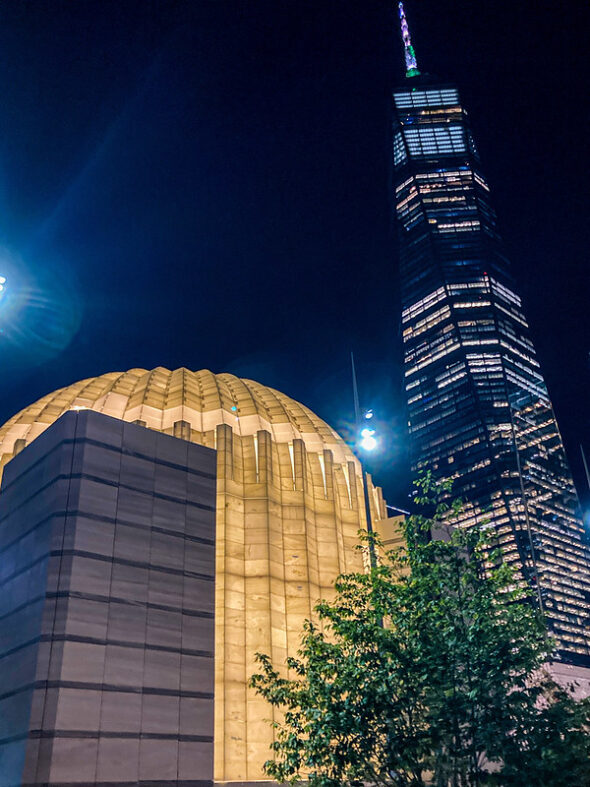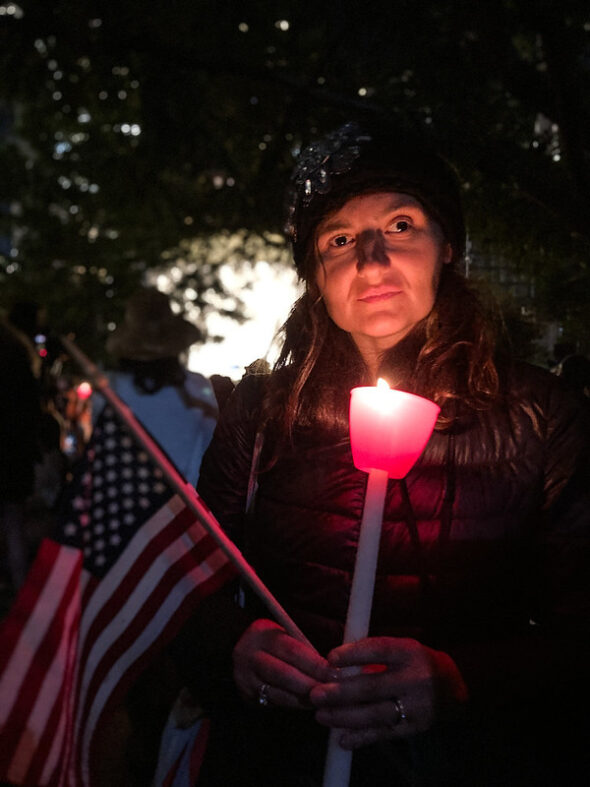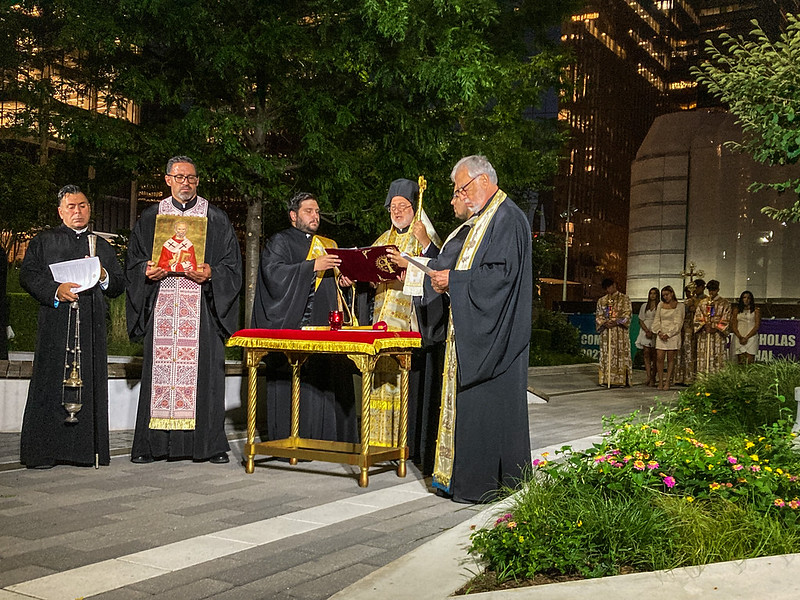The only house of worship destroyed when the Twin Towers fell, St. Nicholas Greek Orthodox Church and National Shrine was illuminated from within on the eve of the 20th anniversary of 9/11.
Interfaith parishioners, religious leaders, and 9/11 mourners gathered in the shadow of the World Trade Center to watch St. Nicholas’s translucent Greek marble–mined from the same vein that supplied the Parthenon–glow for the first time in the darkening evening.
Archbishop Elpidophoros of America led those gathered in a Greek Orthodox mass service: the resurrection service usually reserved for Easter. Attendees, dressed elegantly in somber colors, wordlessly tilted their memorial candles to light one another’s flames. Turning to face the church and with his candle held aloft, Archbishop Elpidophoros commemorated the attacks and all those who died in them.
“The day of 9/11 was no less than the crucifixion of our nation, and the reopening of St. Nicholas is its resurrection,” said Archbishop Elpidophoros.
Light cascaded from the building’s dome to its foundation in a spiritual display.
The rebirth of St. Nicholas Church was long beset by financial and construction difficulties. Building began in 2014, following years of negotiations with the Cuomo administration that yielded a land swap: 155 Cedar Street was exchanged for the nearby and four-times-as-large plot that now houses the church at 130 Liberty Street.
One of the final components of 9/11 rebuilding in Lower Manhattan, St. Nicholas Greek Orthodox Church and National Shrine is set to open its doors later this fall. This reopening is the result of, “construction literally around the clock, the fundraising that made this possible, and the prayer that brought us to this day,” said the Archbishop.
In its new location, St. Nicholas is just a stone’s throw from its old site, and it overlooks the World Trade Center

The rebuilt Saint Nicholas Greek Orthodox Church and National Shrine glows in the shadow of the World Trade Center, twenty years after its destruction on 9/11. Photo by Annie Iezzi
Plaza, which was teeming with security guards the evening of the event. Also in attendance were members of The Friends of St. Nicholas, a nonprofit 501(c)3 that gathered funds internationally for the project. As of this fall, the diocese and The Friends of St. Nicholas have raised $95 million for reconstruction, lighting embedded in the walls, and upkeep of the church and national shrine.
Barbara Katsos, the wife of a member of the Friends of St. Nicholas and a longtime attendee of the original church, called the evening a “monumental moment.”
“The light, for me, represents the resurrection of St. Nicholas and the resurrection of New York City,” she said, noting that the church has been a bastion of the Greek community for generations. “It began as a tavern,” she said, “where all of the Greek immigrants from Ellis Island would come to rest.”
In 1916, the tavern was converted into a church by Greek community members and named for Saint Nicholas, the saint of seafarers, who protected their journey to America. Now, the rebuilt church and shrine displays imagery both religious and secular, featuring carvings depicting saints alongside portraits of 9/11 first responders. Committed to providing an interfaith space of reflection, St. Nicholas Greek Orthodox Church and National Shrine will host mass, as well as educational events and memorials for mourning families on its two dedicated bereavement floors.

Carmen Alexandra, a Greek Orthodox woman who attended college across from the Twin Towers and worked at the Chase Bank Plaza nearby, shares that she visits Ground Zero every year to reflect. Photo by Annie Iezzi
“Did my faith bring me through? Yes. I had friends who died very young, related to 9/11,” said Carmen Alexandra, who attended Borough Manhattan Community College across from the Twin Towers.
She would eat lunch at The Sphere, a sculpture that stood between the towers and was crushed by their debris. Its crumpled shell has since been relocated to the campus of St. Nicholas Church and transformed into a 9/11 memorial, which Carmen Alexandra visits every year.
During the service, she coughed quietly, the flame of her candle wavering as she moved. Following the attacks, Carmen Alexandra worked in the nearby Chase Bank Plaza, which she said has given her long-term respiratory and lung problems, before becoming a nun.
“I thought I should be working,” she said. “Everybody I knew was leaving the city. But I wanted to stay here. I wanted to be in my city; I wanted to be here.”


